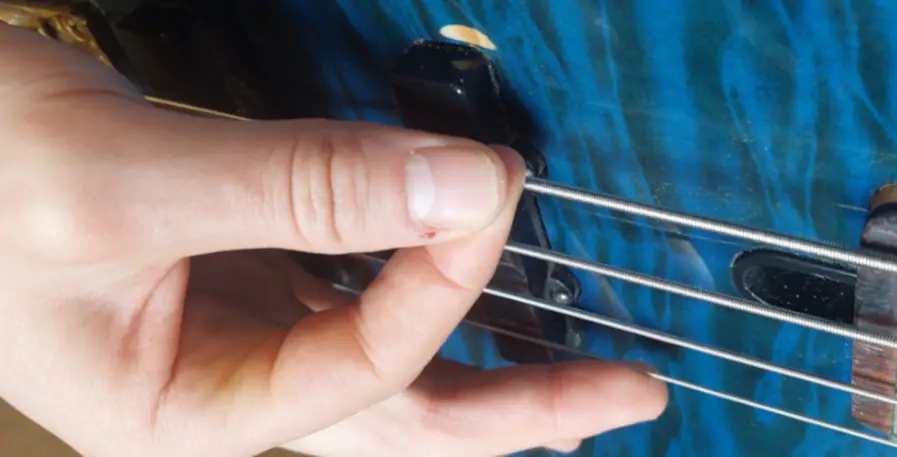Slapping, using a plectrum, or playing with your fingers are the most common ways to play the bass, However, as demonstrated in my guide on using a coin as a bass pick, there are other options. One of these is to play it like you were using a pick, without actually using one, which is also known as chucking.
In my experience, the name of this technique is less well-known than the technique itself.
When practicing, I have oftentimes found myself playing pick-style without a pick just because I didn`t have one laying around. I`ve also heard many accounts of other bassists doing the same, with most of us doing so long before we ever heard it be called “chucking”.
Thus, due to the lack of information surrounding this playstyle, I decided to make this guide. I`ll explain what chucking is, how it compares to playing with a pick, and how the technique fares in terms of tone and playability. I`ve also thrown in 4 exercises specifically aimed at practicing chucking.
Chucking Explained
When “chucking”, the bass is played similarly to when it is picked with a plectrum. However, instead of actually holding one, the fingers are used to simulate playing with a plectrum.

The technique is mainly associated with Bernard Edward; the bass player of Chic. While he was not the first to use his fingers to simulate a plectrum, the technique has largely become associated with his play style. Some also claim that he coined the term himself.
In Edward`s case, he used chucking to play fast and groovy lines in a unique fashion. Sometimes he would base entire bass lines around this technique, with lines generally consisting of fast 16th-note rhythms. Other times, he would also stick to a traditional way of using his fingers.
Most notably, he also demonstrated how chucking can also be used intermittently. A song might have parts you want to play with your fingers and others you want to play with a pick. Then, if you don`t have the time to switch to and from a pick mid-song, you could elect to chuck them instead.
Lastly, even though many associates the technique with Edwards, it is perfectly possible to use chucking any way you like. Before you commit to developing your own plucking style though, it can be beneficial to weigh the pros and cons of chucking over using a pick.
Chucking VS Plectrum
While the technique can be used in many ways, the general tone of chucking is thick and balanced.
Tone-wise, the technique serves as a middle ground between playing with your fingers and a pick. Thus, Chucking could be worth a shot when a pick sounds too sharp and your fingers sound too mellow.
Chucking also does give you a further layer of flexibility in terms of tone. That is, you can elect to pluck notes with either the nail or the bare skin of your fingers. Personally, I find it more natural for my nail to touch the string on both up and down strokes. However, more tonal options are never a bad thing.
As for playability, I consider chucking to be a more demanding and advanced form of playing with a pick. This is because a pick affords you better control of the strings and of their resonance. It will also be less painful for your fingers to pick the string with a plectrum.
Furthermore, a rhythmic chucking style like Edwards’s takes a long time to develop. In my case, I`ve practiced it on and off through the years, and I still have a long ways to go before I can comfortably claim to be able to use it well.
Thus, I`d recommend mastering how to hold a bass pick and play with one, before dedicating significant time to practicing chucking. Though, if you are an intermediate bass player or a beginner who cares deeply about mastering this particular style, read on for some exercises on how to do so.
Chucking Exercises
In the case of Bernard Edwards, chucking is not only about tone, but playstyle and groove.
Becoming proficient at chucking is thus all about developing control of your plucking hand, and muting strings proficiently.
Here are 4 exercises for practicing chucking on the bass guitar that gradually increases in difficulty. Start by practicing them as slowly as you need. You might find it natural to start as slow as 50-60 BPM. For an upper limit on where to stop, I find that they sound best in the 110 BPM to 125 BPM range.
Also, keep in mind that utilizing chucking in this way is an intermediate bass technique. Thus, beginners who attempt these exercises should not feel discouraged if they feel overly demanding. I`ve added a 75 BPM practice track, and a 115 BPM full speed track for all exercises.
First, exercise 1 consists of just muted notes:

75 BPM:
115 BPM:
As you become comfortable with just this rhythm, you can start incorporating multiple strings into the groove.

75 BPM:
115 BPM:
Then, you can elect to add melodic notes as well. This makes the line noticeably trickier to play, as muting and opening bass strings will start to require a good bit of precision, especially at higher tempos.

75 BPM:
115 BPM:
Lastly, combine everything you have learned so far. This includes playing muted rhythms, switching between strings, and playing melodic notes.

75 BPM:
115 BPM:
Conclusion
In conclusion, I find chucking to be a fun way to mix things up when playing the bass. It`s a helpful way to come up with new grooves and to develop better control of both my plucking and fretting hands.
Making chucking an integral part of your playstyle is something that will require a good bit of practice though. If you intend to play fast and groovy lines like Bernard Edwards, this also requires a strong sense of rhythm and being able to serve the song while playing a complex line.
For anyone who is serious about mastering chucking, I will thus say 2 things. First, prepare yourself to practice a lot before you are able to use the technique in meaningful ways. Second, make sure to assess whether chucking will be a fitting way for you to play bass in a band.
For anyone looking to become proficient at chucking after answering these two questions, I say go for it. It is a virtuous technique, that can elevate your bass playing to new heights, and if you master it and apply it the right way, can make you truly stand out as a bass player.

